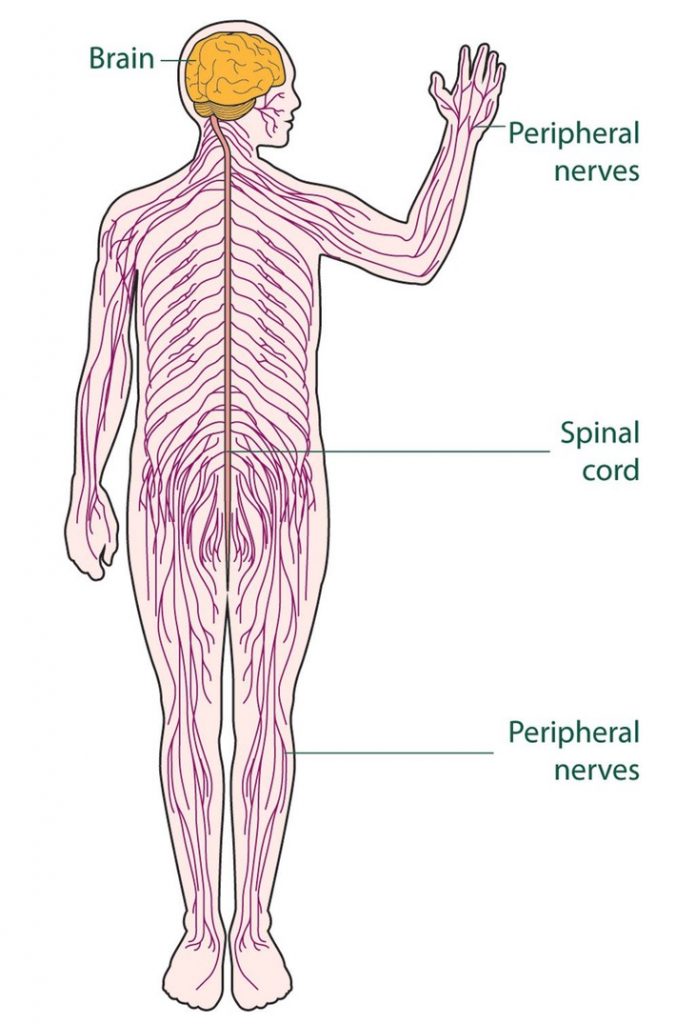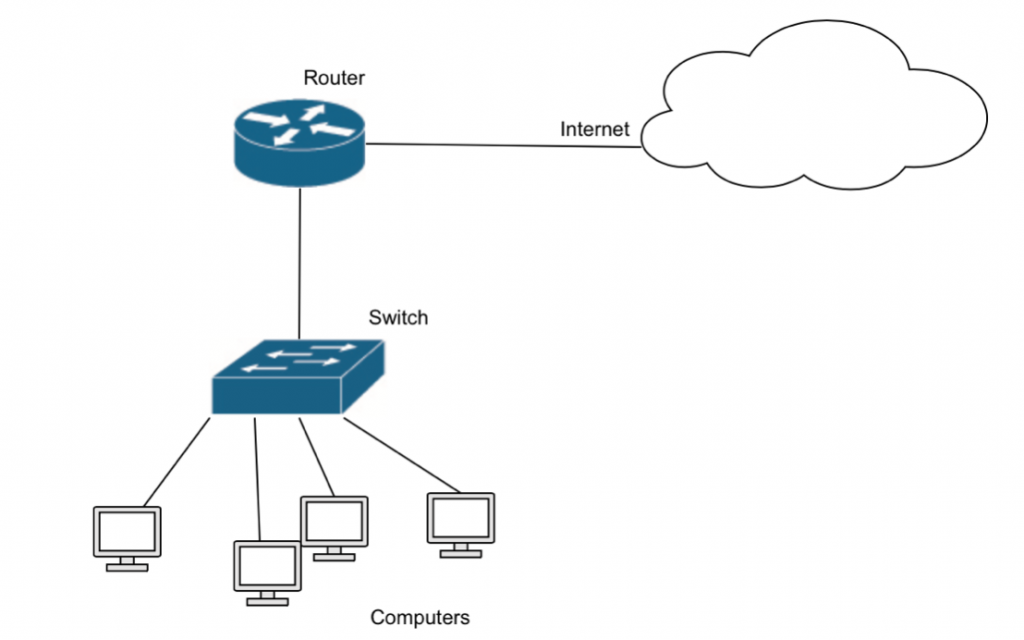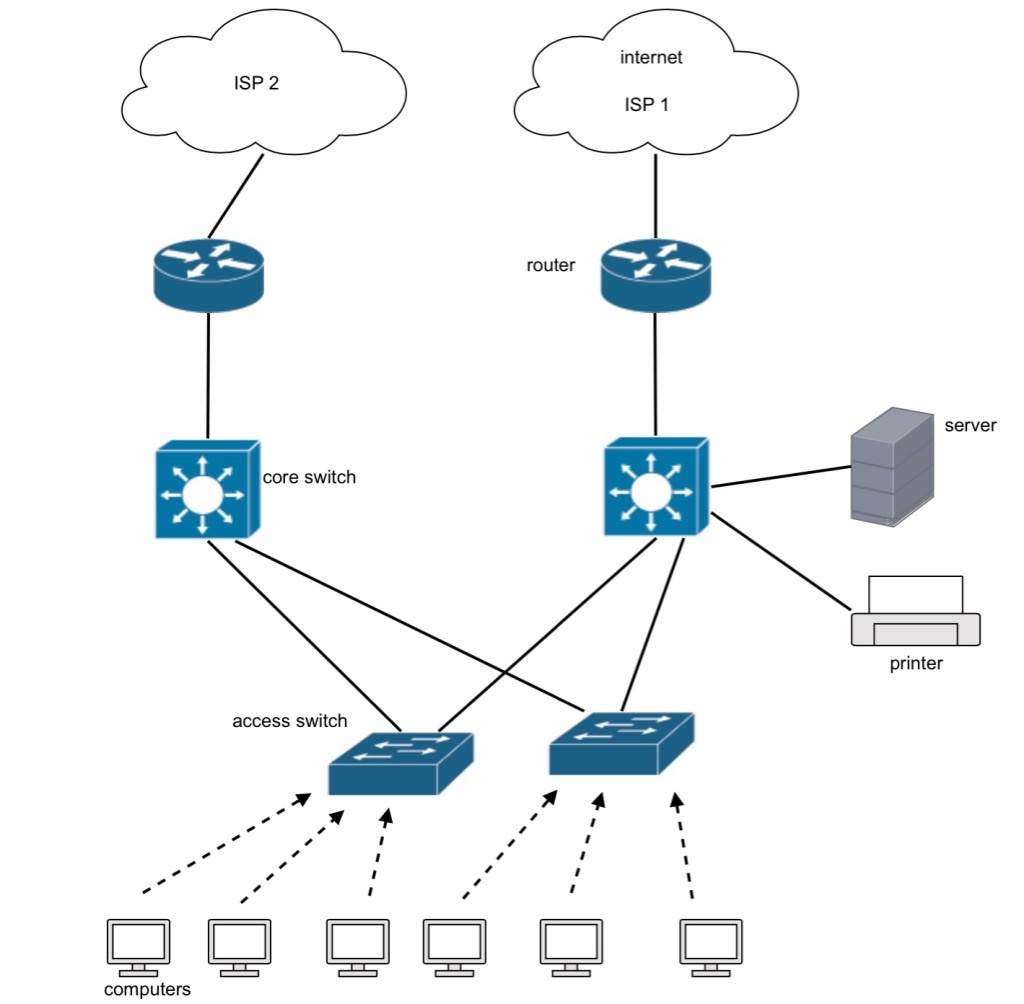On this article, ididiscuss at isha-share ko sa inyo ang basic and fundamentals of a network. Kagaya nga ng sinabi ko, tagalog or taglish ang mga lessons natin para mas maintindihan at mas maunawaan ng ating mga kapwa Pinoy. Let’s go!
What is a network and how it works?
In the technology world, ang network(computer networking) ay combination or grupo ng mga computers at devices connected together na nakaka-pag communicate sa bawat isa.
Nagkikita-kita at “nagkakapag-usap” sila sa pamamagitan ng mga “network connections, standards and protocols“. Ibig sabihin, pwede silang mag-share ng mga data, resources at services to each other.
It’s like a “system” kung saan ang mga “components” ay magkaka-ugnay at magkaka-konekta in order to share information or data.
Think of it like our nervous system.

Our “nervous system” has different components or body parts to make the whole nervous system works, right?
May mga components(body parts) na magkaka-ugnay to make it work so it can function properly. For example, our senses gather the information and pass them to our brain with the help of our nerves. Each part has different functions and roles. Pero collectively, as a group, they are called nervous system.
In computer networks ganun din.
It’s a combination or group of components connected to each other na nagco-communicate at nagpapalitan ng information to make the whole ‘system’ work. Ang mga components(devices, cables, protocols) ay may kanya-kanyang functions to make the whole ‘network’ works.
In a large scale, ang network ay binubuo ng mga devices(like computers, smart phones, printers, scanners, servers, ip cameras etc.) connected via network cable or wireless running on a set of network protocols like ip addresses, routing protocols and more.

For example, typically sa isang opisina, ang mga computers, laptops, printers, scanners at iba pa ay naka-connect sa mga network switches. Ang mga network switches na ito naman ay naka-connect sa router.
Ang router naman ay naka-connect sa ISP(internet service provider like pldt or globe) para maka-connect naman sa internet(or other branch office kung meron).
That way, ang mga employees na gumagamit ng kanilang computer ay nakaka-connect sa internet because they are part of the network.
They can also “communicate” sa ibang devices inside their office to share data and resources dahil part sila ng network. The devices can understand and communicate with each other because of the network.
They can send or receive and email because of that network connection. They can access websites on the internet. They can access files and resources na pwedeng located sa ibang branch office nila. Pwede din nilang ma-access ang mga social media sites and more.
They can also use a network printer na naka-connect lang sa isang computer sa office at pwedeng doon na lahat nagpi-print. The ‘data’ or information can be passed through the network because of the ‘network components’ na bumubuo sa network.
Kagaya nga ng nabanggit ko, ang mga components na ito ay binubuo ng mga devices like computers, printers, servers, smartphones, network cables, network devices and more.
Siyempre kasama din ang mga network protocols na nagsisilbing ‘language’ or ‘way of communication’ ng mga naturang components.
Managed and Unmanaged network
Sa pangkaraniwang bahay or mga residential, katulad sa mga bahay natin, we also have a network. Like what I describe above, it is composed of “network components”. Andiyan ang mga desktops, laptops, smart phones, tablets, printers and other devices na karaniwang ginagamit natin sa ating mga bahay.
Ang mga ito ay connected sa ating “home router” na provided ng ating ISP(internet service provider). Either Globe, PLDT, Converge or others.

Commonly, a normal residential are connected via wireless. We just turn-on the wifi in our smartphone or laptops, put in the correct password and voila, connected na tayo sa internet.
In some houses and residential areas, meron din mga wired connections bukod sa wireless. This is where we used ethernet cable na naka-connect sa router or switch natin, then iko-connect natin sa ating mga devices. Different set-up pero same function and goal like wireless, that is to let us connect to the “outside world” a.k.a internet.
Now, ang mga devices, cables at iba pang network components in a common residential houses or areas are “plug and play” devices.
For example, the home router na karaniwang meron tayo na provided ng ating ISP. We just connect it, power it on and boom, we can connect to the internet(given it was setup correctly by the technician). It is also called unmanaged devices.

Ibig sabihin, we do not configure it manually or kung meron man it is purely basic configuration. In most cases pa, it is via graphical user interface or GUI. Ang mga devices din na ito ay limited ang features and capabilities when it comes to advance networking. Talagang naka-design siya for residential and really small offices.
On the other hand, meron din tayong tinatawag na managed devices. This is where switches and routers from vendors like Cisco and others comes in. Hindi ito kagaya ng mga unamanaged devices na plug and play. Ang mga devices na ito(managed) ay kailangan i-configure at “i-manage” bago magamit at mapakinabangan.
Marami rin ang mga features and capabilities nang mga managed devices. Pwede natin ma-control at ma-prioritize ang network traffic through our managed devices. Dito pumapasok ang mga tinatawag nating vlans, routing, switching, voip, qos and more. Karaniwan din, ito ay kino-configure via cli or command line interface.
Ang malalaking companies like banks, international organizations, bpo, call centers ang mga karaniwang gumagamit ng mga managed devices na ito. At tayo bilang mga network administrator at network engineer ang mga nagha-handle at nagko-configure ng mga devices na ito.
As we go along in this blog, we will talk about more of the features and configurations of different managed network devices kagaya ng switches at routers.
In a normal enterprise, a BPO for example, the network consist of many different components. It has hundreds(if not thousands) of end devices like laptops and computers, smartphones, printers, scanners, ip phones, cctv camera, alarm devices, servers, switches, routers and a whole lot more.
Marami ding involve na network protocols and standards like ip addressing, switching, routing protocols, voip and more. They are all interconnected sa isa’t isa at part ng buong network.
Alam ko it can sounds confusing for now pero don’t worry, hihimay-himayin natin ang mga yan moving forward.
In a smaller scale, two computers connected to each other is also considered a network.

Dito sa ating example, ang dalawang computers na ito ay directly connected sa pamamagitan ng network cable. At ito ay matatawag na natin na isang network. Maari na silang “magkita at mag-usap” and then kagaya nga ng sinabi natin kanina, mag-share ng resources at services. They can exchange data back and forth.
For example, I can share a folder or a file dito sa isang PC na nasa kanan and I can access that folder or file sa PC na nasa kaliwa.
Or di kaya naman, kung merong printer na nakakabit sa PC na nasa kanan, I can also use that printer para makapag-print gamit ang PC na nasa kaliwa(given na ito ay naka-set as network printer). I can save or retrieve file back and forth from each PC given na sila ay connected. And so much more.
You get the idea?
The concept is to share data and resources back and forth. Or allow communication between different devices and components.
Like what I said earlier, in a much larger view, ang network ay binubuo ng multiple computers and devices interconnected to each other sa pamamagitan ng mga networking equipments. Halimbawa na lang ay ang switches at routers. Idi-discuss natin ang mga ito sa susunod.
Here’s another example of a network having multiple computers and devices.

Dito naman sa example natin sa taas, makikita natin na multiple devices na ang connected sa ating network. At lahat sila ay “nagkikita-kita at naguusap-usap” sa isa’t isa para makapag-process at maka-pagshare ng data or services. They can communicate with each other.
Ito ay simpleng example pa lamang ng isang maliit na network. Sa mga businesses at organizations ngayon, ang network ay binubuo ng daan-daan or libo-libong computers at mga devices connected to sa isa’t isa.
See a sample enterprise network diagram below.

Network ang nagsisilbing tulay para makapag-communicate at makapag-process ng information ang mga company at ibang institutions today.
Ang pagdagdag, pagpasa, pag-uupdate at iba pa, ng mga impormasyon sa mga applications at programs na ginagamit ng mga businesses, banks, enterprises at iba pang organizations ay nagiging posible dahil sa network connections.
At hindi lamang limited sa isang location or lugar, they can be inter-connected overseas or “virtually anywhere“.
Dito pumapasok ang Cisco or ibang networking equiment vendors. Sa mga malalaking network gaya ng network ng mga fortune 500 companies, governments and other organizations, kelangan na i-manage at i-maintain ang network para sa pag-unlad at security ng business or organization.
Gaya ng nabanggit ko kanina, gumagamit sila ng mga tinatawag natin na “managed devices” gaya ng mga Cisco routers and switches to support their network infrastructure.
Ang mga managed devices na ito ay may kakayahan upang i-support ang malalaking network at maraming special features na hindi available sa mga pang-karaniwang network devices. Halimbawa na lang ay ang vlan, switching protocols, routing protocols, nat, voip, at marami pang iba.
We’re going to talk each of them in the future lessons. Network serve as the “backbone and nerve” of almost every company and organizations today. We can safely say na kung walang network, wala ring civilizations like what we have today.
Bilang isang CCNA, or isang network administrator or network engineer, ang role at responsibility natin ay i-maintain, i-optimize at i-troubleshoot ang network or ang connections ng mga computers at devices na ito.
In a more technical terms, tayo ang mag-mamanage ng mga “path” or daanan ng mga computer at devices na ito kung pano sila “magkikita-kita or maguusap-usap“.
Mostly, we work in a managed network infrastructure kagaya nga ng mga banks and bpo na nabanggit ko kanina. Tayo ang mag-coconfigure ng mga networking devices kagaya ng Cisco switches and routers para ma-establish ang connections nila sa isa’t isa.
Tayo rin ang mag-coconfigure ng mga “standards and protocols” kung papaano sila magkikita-kita or mag-uusap usap. At yan ang mga ididiscuss natin sa mga susunod na lessons.
Thank so much man, this will really help me a lot since I’m a beginner my self, and I’m interested in learning ccna, tnx. Man
Hi Sir Billy thanks for sharing this. This will help to those who are planning to take the CCNA exam.
Welcome Frank!
Hi Billy,
Tanung ko lang kong saan and HQ ng iyong boot camp sa sa PI kasi uuwi ako by next month gusto ko makita ang lab o class room other wise I just need your advise of how do I start taking basic CCNA base diyan sa PI. If I can do it for 1 to 2 months if possible
Thank you
AL
Hi Sir,
San po nakakaavail ng book niyo?
Thanks
Got it sir.
Hello sir, thank you for sharing your ideas. God Bless
Welcome Joefre!
SOLIDD KA IDOL SALAMAT SA INPUT!
Sir u should be the next president! I’m already 27 yrs old, tapos baka next year pa ko makagraduate, for the mean sobrang helpful ng gantong blog para sakin. God bless you and your family!!
Haha! Thanks Joseph!
Wow ang galing mo naman Sir Billy. Thank you for sharing this blog. This helps me a lot.
Welcome Ellen. 🙂
Patawad Ms Aileli Avisado.
Mahal na mahal kita.
I just noticed na bakit parang walang topic about network devices like Routers, Switch, Firewalls, Load Balancers etc.
Hmmm. You may not have read them yet Gen. Go here. 🙂
i got it! thanks for the guide sir!
Maraming salamat po at na enlighten po ako, yes im a computer engineering graduate pero gusto kong mag review na easy lang like ma intindahan agad para sa darating na araw e share ko din ito sa iba salamat po.
Hi sir Billy, Ang gaganda po ng nababasa ko dito, umpisa pa lang mabubusog na talaga utak. Interesado po ako bumili ng Ebook. Nag message na po ako sa email mo, and need ko na lang po ng reply mo. Salamat po idol.
Hi Billy,
CCNA aspitant here with no IT background..thanks for sharing this informations..malaking tulong po ito para sa akin at sa iba. God bless you man!
Hi Sir Billy – Im so excited to learn more of your topics for CCNA. Sa tulad kong nagbabalak to shift back to IT Work, this can be a good start. Thanks po!
Brian McDermott getuajob@aol.com.
Bill
IHave not received the booklet yet. I live in the UnitedStates, I did not knwow if the booklet was only for the Phjlli[pines. Anyways I do want to get back in the CCNA saddle.
Sir billy nag send po ako ng message sa Messanger mo, I’m looking forward talaga to have your book soon ???? ????
Thank you very much
Hi po sir billy paano po maka order nang book po taga cebu po ako. and how much po? thank you po.
This article does an excellent job explaining the fundamentals of a network in a way that is both clear and beginner-friendly. I appreciate the straightforward definitions and the breakdown of how devices communicate and share resources within a network. The inclusion of different types of networks, such as LANs and WANs, adds depth and context, making it a great starting point for readers new to networking. The practical examples and relevance to everyday technology use make the topic more relatable and engaging. Thank you for creating such an accessible and informative resource!
This article provides a solid introduction to the concept of networks, making it accessible for beginners and a great starting point for those exploring the field of networking. The breakdown of key terms like nodes, devices, and data communication is straightforward and easy to grasp. Additionally, the explanation of different types of networks, such as LAN, WAN, and MAN, offers readers a clear understanding of their applications and distinctions. To enhance its value, the article could include visual aids like diagrams or examples of real-world network setups. Overall, it’s a well-written piece that effectively covers the basics of networking.
What is a system of interconnected components that communicate and exchange information to make a network function?
Visit us IT Telkom